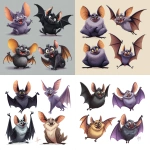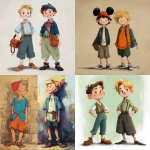Explore the Best AI Image Gallery

Beyond the Brush: How Wearable Tech is Redefining Artistic Expression
The realm of artistic creation has always been a dynamic space, constantly evolving with the introduction of new tools and technologies. Today, wearable technology stands as a groundbreaking force, pushing the boundaries of artistic expression and redefining how we create, interact with, and perceive art.
A New Dimension to Creative Expression
Wearable tech goes beyond traditional mediums, offering artists an array of innovative tools to translate their visions into reality. Imagine:
- Drones that dance in choreographed patterns, creating aerial artworks that respond to music or environmental stimuli.
- Smart garments that transform color and texture based on the wearers emotions or movements, becoming living canvases of self-expression.
- Interactive installations where viewers body movements trigger light displays, sound effects, or virtual projections, blurring the lines between art and audience participation.
These are just a few examples of how wearable technology is empowering artists to explore new dimensions of creativity.
Applications Across Artistic Disciplines
The impact of wearable tech extends across diverse artistic disciplines:
- Music: Musicians can now use haptic feedback gloves to control virtual instruments, compose real-time soundtracks based on movement, or even generate music through their heartbeats.
- Visual Arts: Painters and sculptors can utilize augmented reality (AR) headsets to create interactive artwork that responds to the viewers presence, allowing for a personalized and immersive experience.
- Performance Art: Actors and dancers can integrate wearable tech into their costumes and performances, creating dynamic narratives through light projections, synchronized movements, or even real-time biometric data visualizations.
Ethical Considerations in the Wearable Art Landscape
As with any emerging technology, the rise of wearable art raises important ethical considerations:
- Data Privacy: Wearable devices collect vast amounts of personal data. It is crucial to ensure responsible data handling practices and transparency regarding how this information is used.
- Accessibility and Inclusivity: The cost and complexity of wearable tech can create barriers for certain artists and audiences. Efforts should be made to promote accessibility and inclusivity in the development and deployment of these technologies.
- Artistic Ownership and Authorship: The lines between artist and technology become blurred when wearable art is involved. Clear guidelines are needed regarding artistic ownership, copyright, and attribution in this evolving landscape.
Future Trends Shaping Wearable Art
The future of wearable art holds immense potential:
\n- Increased Integration with AI: Artificial intelligence will play an increasingly prominent role in generating, personalizing, and interpreting wearable art, enabling new forms of creative collaboration between humans and machines.
- Seamless Blending of Physical and Digital Realms: Wearable technology will continue to blur the lines between physical and digital spaces, creating immersive experiences that transcend traditional boundaries.
- Social Impact through Art: Wearable art has the power to raise awareness about social issues, promote inclusivity, and foster dialogue through interactive installations and performances.
Conclusion
Wearable technology is ushering in a new era of artistic expression, empowering creators to push boundaries, experiment with innovative mediums, and engage audiences in unprecedented ways. As we navigate the ethical considerations and explore the future possibilities of wearable art, one thing remains certain: this transformative technology has the potential to reshape our creative landscape for generations to come.

](https://images.ai-img.art/thumbnails/150/269414b0e541026702e9e67c67602c96162f37ff460a388b3b36314c8fc936dd.webp)








](https://images.ai-img.art/thumbnails/150/485c8b1c747827bdc9a962f8a1919b3c259b18dd263b260208a1eae19fb85e07.webp)





](https://images.ai-img.art/thumbnails/150/8d1fe5a7a49cfc96747182431a853357913286d89258383caab2d3b4681afcb5.webp)




](https://images.ai-img.art/thumbnails/150/5197af8969d850e2a43e141d41e482ccbceedebceb2a4caf9f098f943f9d1b0f.webp)




](https://images.ai-img.art/thumbnails/150/2fbd98ecfc425cfc1597779121e1c0305437067779e9c471eb64ff9615d5be98.webp)
















](https://images.ai-img.art/thumbnails/150/3020b8c2b6d9be07e042357107af1de10deb274a41d2b0f332684ad4b532a702.webp)





